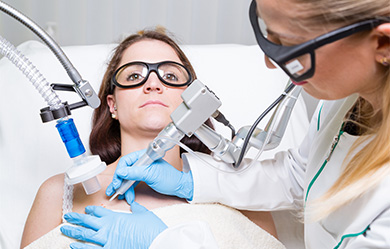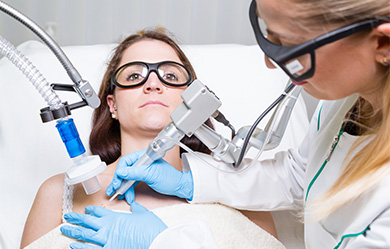In the right hands (that is, well trained and qualified practitioners and therapists using the right equipment, and the right equipment for their level of expertise), laser and IPL for everything from reducing wrinkles and pigmentation to removing unwanted hair and tattoos is usually very successful.
 However, within these conditions lies a maze of complexity and, so, many procedures can require a high level of expertise.
However, within these conditions lies a maze of complexity and, so, many procedures can require a high level of expertise.
Laser and IPL devices are used in a variety of medical and non-medical settings. The ‘elasticity’ of regulation governing these procedures has been a subject of deep concern to the medical community for a number of years, in light of some devastating injuries that have been caused – or just plain ugly results.
The landscape could soon radically change, however, and as a salon, spa or clinic operator owning and using this equipment you should be forearmed and prepared:
- Are you using top quality equipment from a reputable supplier?
- Have you completed a certified laser safety course (and, ideally, more advanced training)?
- Are you operating within the current Australian Radiation Protection and Nuclear Safety Agency (ARPANSA) regulations in your state or territory?
- Are you using the appropriate device technology? For instance, IPL is generally considered contraindicated for tattoo removal. It has been likened to ‘cracking an egg with a machine gun’ with the potential to severely burn and scar a client. This is not only devastating for them but for you as a business owner.
ARPANSA is inviting submissions on: The Consultation Regulatory Impact Statement (RIS) to cover the use of Intense Pulsed Light sources (IPLs) and Lasers for Cosmetic or Beauty Therapy. Submissions close at the end of this month.
‘The current lack of light device operator regulations and standards means that anyone can buy a laser and/or IPL device and set themselves up without requiring training or insurance – this situation really puts individuals at risk,’ says Dr Cath Porter, Sydney cosmetic physician and spokesperson for the Cosmetic Physicians Society of Australasia (CPSA).
Adds Brisbane cosmetic physician Dr Mary Dingley, who has been involved in developing the Australasian College of Cosmetic Surgeons (ACCS) laser safety initiative: ‘The use of lasers and IPLs has exploded in recent years but there are many operators out there that have no basic understanding of how the equipment they are using interacts with tissues and therefore are putting both their clients and themselves at risk.’
CPSA president Dr Gabrielle Caswell, a cosmetic physician who runs Eyra medi-clinics in regional NSW specialising in treating sun-damaged skin and skin cancers, has been party to driving the review of the regulations governing laser and IPL use.
‘It was a four-year project to get it to the stage for public consultation,’ says Dr Caswell. ‘In essence it is aiming to professionalise the profession on all levels. I insisted that doctors also have to do a basic laser safety officer course. ‘The idea is – if you don’t have the education, training and insurance, don’t do the deed.’
Dangerous lasers imported direct from China are being blamed for a surge in severe burns and scarring among tattoo removal clients. For instance, Queensland Health has recently launched raids to seize lasers and business records from unethical operators.
Some of the lasers reportedly seized to date were unlabelled or labelled as Class 3, which do not require permits to operate. But some seized have been identified as Class 4 which, under Queensland law, require a licence. Operators also need to have undergone training to use the more powerful lasers.
‘In the wrong hands, laser equipment like this can cause significant harm,’ says Queensland Health Minister Cameron Dick.
‘The effects can be devastating and long-lasting, Not only have clients been burnt but subsequent infections have exacerbated the situation.’
Another major issue is that incorrect treatment using an IPL or laser by untrained or inexperienced operators can potentially remove or mask unrecognised or undiagnosed symptoms of melanoma or non-melanoma skin cancers.
‘This could have serious consequences, including eventual death from skin cancers that are detected too late because an IPL or laser operator has masked a symptom of skin cancer,’ according to ARPANSA’s Radiation Health Committee (RHC) Working Group.
The working group conducted a voluntary, anonymous survey from November to December, 2012, of registered health practitioners and non-medical practitioners in Australia seeking data on accidents/incidents caused by the use of lasers and IPLs.
‘The survey drew 430 responses from five medical practitioner groups (38 percent) and six other health and beauty practitioner groups (62 percent),’ the RHC Working Group reported.
‘Responses by medical practitioners in the 2012 survey showed that there were 62 cases in a 12-month period in which a diagnosis of skin cancer was missed or delayed because a pigmented lesion was incorrectly treated with an IPL or laser. Of the 62 cases there were 22 cases where diagnosis of a melanoma was missed or delayed.
‘Melanoma is the most dangerous form of skin cancer with a highest mortality rate and early detection is crucial.’
Doctors recommend that clients presenting for laser or IPL treatment should have had a skin cancer check in the six to 12 months prior, for their saftey – and your peace of mind. The use of light on cancerous lesions can accelerate their growth, or even trigger pre-cancerous lesions to the next stage.
To read the draft guidelines in The Consultation Regulatory Impact Statement (RIS) to cover the use of Intense Pulsed Light sources (IPLs) and Lasers for Cosmetic or Beauty Therapy visit www.arpansa.gov.au/Publications/Drafts/dr_ndrpIPL.cfm




